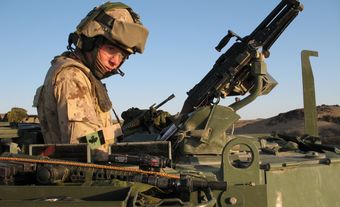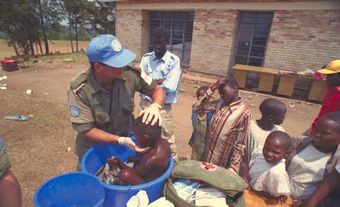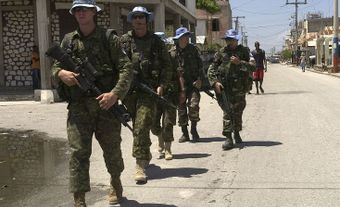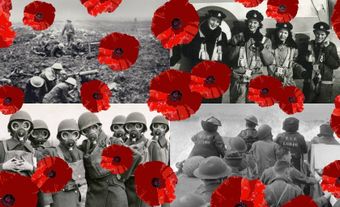Brigadier-General (retired) Chris Ayotte enrolled in the Canadian Armed Forces in 1992 and graduated from the Royal Military College in 1996 with a degree in chemical and materials engineering. A member of the Royal Canadian Engineers, BGEN (ret'd) Ayotte served across Canada on multiple domestic operations and internationally in the Balkans, Afghanistan and the Middle East. He retired from the military in 2022 after 30 years of service. In 2024, BGen (ret'd) Ayotte shared with Historica Canada his experiences as a combat engineer officer in Kosovo.
Please be advised that the following written account does not necessarily reflect the views of Historica Canada.

It seems every new member of the military is concerned about missing out on an overseas operation. This is because being “deployed” is when a soldier has the opportunity to put their training into action. It’s professional self-actualization. The adventure during a deployment is why many Canadians enrol in the military. It was one of my main motivations to sign up over three decades ago. This military FOMO [fear of missing out] continues to this day, despite the world being in no threat of breaking out into peace anytime soon.
I arrived in Edmonton in 1997 and my first major training event was centred around getting the next group ready to deploy to Bosnia. In fact, almost everything I did from arrival onwards was focused on preparing teammates for the next mission in the Balkans. I was immersed in all aspects of deployments, except actually deploying. If I wasn’t helping to train people for an upcoming deployment, then I was hearing stories of past deployments — Kuwait, Croatia, Pakistan, and Rwanda. Or I was looking at all the memorabilia of past deployments which is plastered across the walls of every military unit.
After two years, and much to my relief, I was selected for my first international deployment in 1999. It was to be a new NATO mission in Kosovo. As some will remember, a NATO aerial bombing campaign began in March of that year with the objective of stopping the ethnic cleansing of Kosovar Albanians by the Serbian military. In the event Serbian President, Slobodan Milosevic, capitulated and withdrew his forces from the province of Kosovo, NATO would establish a ground presence. The Kosovo Force’s, or KFOR’s, original objectives were “to deter renewed hostilities, establish a secure environment and ensure public safety and order, demilitarise the Kosovo Liberation Army, support the international humanitarian effort and coordinate with the international civil presence.”
Since the aerial bombing campaign was still ongoing, we could not simply fly into Kosovo. NATO started to stage out of neighbouring countries in preparation for a possible ground campaign. Our Canadian team was attached to the British 4th Armoured Brigade that was building up just outside of Skopje, Macedonia. As the engineer squadron operations officer, I joined a small reconnaissance team tasked with finding a place for our group to set up. We were first to deploy, and this took the form of travelling in a military CC-130 Hercules aircraft from Edmonton, Alberta, to Skopje, Macedonia, via Trenton, Ontario, Gander in Newfoundland, and some nondescript location in the UK before arriving at our destination. It was like being placed in a gentle paint shaker for three days with six of your closest friends.
As many veterans will attest, even with the entire team in Macedonia, there was no guarantee we would ever enter Kosovo. At the root, military conflict is a battle of human wills and if Milosevic did not buckle under the pressure, NATO would stay put. After a 78-day bombing campaign, we entered Kosovo through a southern route known as the Kacanik defile. This is a mountain pass which made us vulnerable to any remaining Serbian forces that wanted to stay and fight. I remember the emotions — stress, anxiety, and excitement — being high as we crossed the border into Serbia not knowing what awaited us. Unlike the modern battlefield where uncertainty can be reduced with constant communications, satellite imagery, and drones peaking around every corner, we had none of that. We had old fashioned army radios and paper maps as our guides on our advance northwards.
As we emerged from the Kacanik defile we encountered refugees heading south away from the violence. This was not a few people, but hundreds, if not thousands, of Kosovar Albanians seeking safety. They were relieved to see us, but there was an unmistakable fear on each face. As we rolled further north it became clear why so many people were on the move. We came across significant pockets of Serbian military forces scattered throughout the area and numerous houses on fire, likely set by the former as an act of retribution.
Although the distance from Skopje to Pristina is less than 100 km, we were ordered to spend the night somewhere between the two cities. We ended up establishing ourselves in the village of Uroševac in an old abattoir. I have no idea who made that decision, but it was the least of our worries. The Serbian military still occupied the village, and this kept the tensions high for the locals and us. After a couple of hours in town, my boss headed off on a reconnaissance of the area, so I was left “in charge”.
No sooner had he left than a soldier radioed saying there was situation at the front gate. A local Kosovar had brought us two critically injured civilians. A father and his young son had been wounded while trying to move a piece of unexploded ordnance. Our medics jumped into action while we radioed for a medical evacuation to bring the wounded to the Pristina hospital. After what seemed like an eternity, a British ambulance arrived and rushed the son off to the capital. We were left with the father’s body and spent the next couple of hours driving around with him trying to find family or friends who would handle him with dignity.
We pushed off early the next morning for Pristina and were soon in the middle of the Kosovo equivalent of the land rush in the American West. Every military unit converging on the capital was looking for a place to call home. The British headquarters grabbed a vacant office building, our Canadian armoured squadron pulled into a recently vacated Serbian Army base, and we planted our flag in a partially finished warehouse. This would be our home for the next seven months as we started to help the Kosovar people set the foundation for the future.
Most Canadians will never have these types of experiences and that’s the way it should be. However, it is important to appreciate what we expect our military personnel to do on our behalf and why it matters. In this example, during my first 48 hours in Kosovo I bore witness to thousands of refugees, a scorched earth campaign, the damage weapons of war inflict on the human body, the sorrow of a family taking possession of a loved one’s remains, and the joy of learning the little boy survived his wounds. The why we do these things does not always end up the way we hope, but it has with Kosovo.

 Share on Facebook
Share on Facebook Share on X
Share on X Share by Email
Share by Email Share on Google Classroom
Share on Google Classroom








